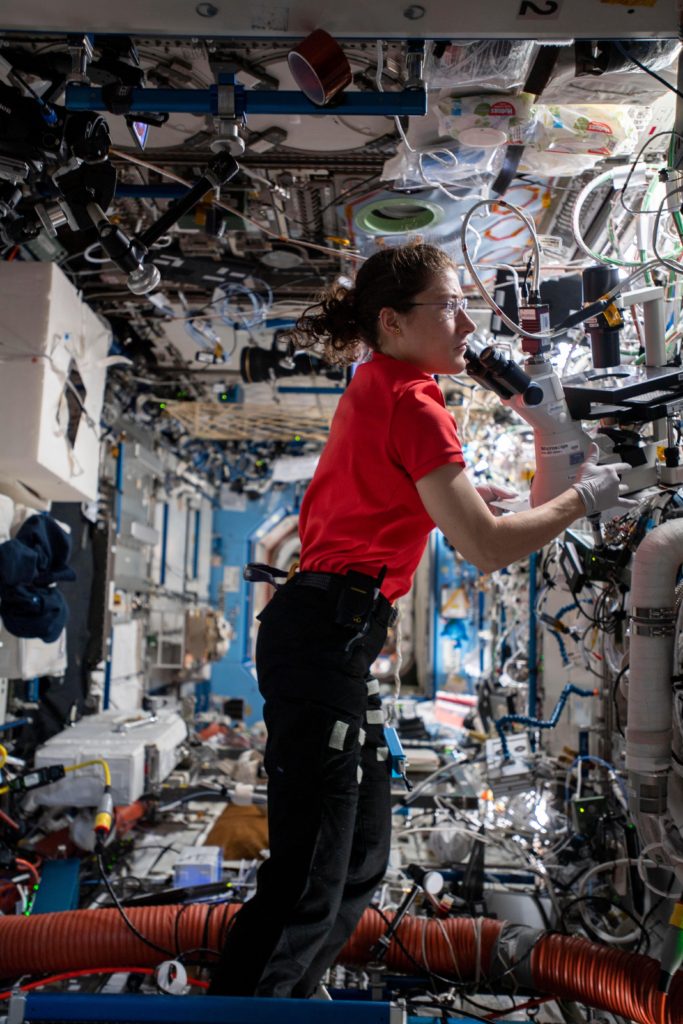
Yesterday morning, history was made in snow-covered fields in a usually remote area of Kazakhstan. The Soyuz M-13 space capsule returned to Earth from space, landing on soil after undocking from the International Space Station (ISS). The capsule carried three astronauts back to Earth: National Aeronautics and Space Administration (NASA) astronaut Christina Koch, Russian cosmonaut Alexander Skvortsov, and European Space Agency (ESA) astronaut Luca Parmitano. Koch’s return in particular is making headlines due to her record-breaking accomplishments aboard the ISS. Koch emerged from the Soyuz space capsule smiling ear to ear with two thumbs up after 328 days orbiting Earth.
Koch now holds the record for the longest spaceflight by a woman and second-longest by an American. She completed 5,248 orbits around the Earth, a journey of 139 million miles, and a total of 42 hours and 15 minutes outside the station. On October 18, 2019, Koch made history along with NASA astronaut Jessica Meir by conducting the first all-female spacewalk.
Ronald Ankner ’19 is preparing to start his fourth internship at NASA this summer and has had the opportunity to meet several astronauts as well as attend two “Return Home” ceremonies. When asked about his reactions to the history-making spacewalk, he said, “The October spacewalk was an awesome step in the history books, but I think sometimes branding it like this never-before-done feat overshadows a lot of the awesome work women astronauts do and have been doing for a long time.”
Ankner further explained what he believes is a large problem in the conversations about women in STEM. He said, “a lot of people react with ‘Wow, a crew of only women did a spacewalk,’ airing an underlying tone of surprise, but my reaction is ‘yeah, they’re incredible people and very highly trained’ […] we’ll know as a society that disparity is gone when no one bats an eye at an all-female crew, they just treat it as very highly-qualified people doing something incredible to begin with, making no mention of their gender.”
During her time on the ISS, Koch conducted research across a wide range of topics including botany studies, kidney diseases, and fuel efficiency. She grew leafy greens to understand the effects of gravity and spaceflight environment on plant biology at levels as sophisticated as cellular and tissue. For future long-term space expeditions, carrying food on the spacecraft is unrealistic; however, astronauts growing their own food is more attainable and feasible. She also studied how kidney health is affected by microgravity, water conservation, altered diets, and other factors, which helps protect not only the health of astronauts but also the health of people on Earth. Researching how fire behaves in space, Koch also worked on the Advanced Combustion via Microgravity Experiments (ACME) Chamber insert to study the prevention of spacecraft fires and other effects of fire in space.

In an interview with NASA aboard the ISS, Koch explained that her favorite experiments she worked on were “the ones that have uncovered something new, and that contribute to betterment of life on Earth for people in a tangible way, and what that translates to up here would be the pharmaceuticals research.”
In microgravity, Koch was able to grow protein crystals that are not possible to grow on Earth. According to NASA, the Microgravity Crystals investigation “crystallizes a membrane protein that is integral to tumor growth and cancer survival. Results may support the development of cancer treatments that target the protein more effectively and with fewer side effects.” These protein crystals that are grown under microgravity conditions are more organized and larger than ones grown in the presence of gravity on Earth. Besides treating cancers, this research may also aid in the creation of new drugs and additional technologies across other disease areas, including Alzheimer’s and Parkinson’s diseases.
Although Koch conducted several experiments herself, she was also participating in an experiment just by being in space. As a research subject volunteer, she helped provide information on how the human body adjusts to weightlessness, isolation, radiation, and the stress of long-duration spaceflight. Spending nearly one year in space will further prepare NASA for a return to the moon and human exploration of Mars under the Artemis Program. Ankner commented on Koch’s accomplishments by explaining, “I think her extended stay in space will provide humanity with a vast new set of information to work with. Especially as we are moving closer to Deep Space Gateway and possibly Mars afterward, her contribution of physical, mental, and biological data alone is huge (along with all of the work she did while she was up there).”
Koch’s research and participation as a research subject volunteer is providing NASA with data that will prepare for the future. Koch and the rest of the crew contributed to hundreds of experiments in biology, Earth science, human research, physical sciences, and technology development. NASA astronauts Jessica Meir and Andrew Morgan and Russian astronaut Oleg Skripochka remain on the ISS to continue research and experiments. In early April, they will grow to a six-person crew as one NASA astronaut and two Russian cosmonauts will launch to the station, continuing humanity’s development in space research and exploration.
Be First to Comment